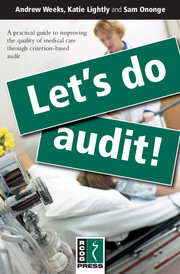 Let's Do Audit!
Let's Do Audit! Book contents
- Frontmatter
- Contents
- Acknowledgements
- Introduction
- Lesson 1 An introduction to clinical audit
- Lesson 2 Problem identification
- Lesson 3 Setting standards and establishing criteria
- Lesson 4 Measuring current practice
- Lesson 5 Analysing the data and comparing practice with agreed criteria
- Lesson 6 Implement change and re-audit
- Conclusion – let's do audit!
- References
- Appendix. Worked examples of audits
- Glossary of terms
- Index
Lesson 6 - Implement change and re-audit
Published online by Cambridge University Press: 05 July 2014
- Frontmatter
- Contents
- Acknowledgements
- Introduction
- Lesson 1 An introduction to clinical audit
- Lesson 2 Problem identification
- Lesson 3 Setting standards and establishing criteria
- Lesson 4 Measuring current practice
- Lesson 5 Analysing the data and comparing practice with agreed criteria
- Lesson 6 Implement change and re-audit
- Conclusion – let's do audit!
- References
- Appendix. Worked examples of audits
- Glossary of terms
- Index
Summary
Introduction
After all the work collecting the data for the audit is completed, it may feel as if the work is nearly over. In fact, it is only just beginning. The implementation of change is the most important step in the audit cycle. It is also the hardest but most rewarding step to achieve. Many factors must be considered to perform it properly. Do not forget that the reason that audit is performed is to find out what shortcomings there are in the system so that we can try to improve them. Only when it has been established exactly what suboptimal care has occurred, can we address the specific issues that have caused it and implement changes in practice.
Assuming that audit reveals some aspects of care which measure up poorly against the agreed criteria, the next step is to promote appropriate change in practice. There are five principal explanations for care falling short of agreed standards:
1. The agreed criteria are invalid or the standard is unrealistic.
2. The organisation is deficient. This could be in staff, supplies, distribution, workload or leadership.
3. Knowledge is inadequate.
4. Skills are inadequate owing to a lack of training or supervision.
5. Attitudes are inappropriate – there may be a lack of accountability, poor motivation, unmet personal needs or unclear job descriptions.
In choosing approaches that might persuade colleagues to change, it is important first to determine the reason for each deficiency. Sometimes the explanation may be glaringly obvious.
Information
- Type
- Chapter
- Information
- Let's Do Audit!A Practical Guide to Improving the Quality of Medical Care through Criterion-Based Audit, pp. 47 - 58Publisher: Cambridge University PressPrint publication year: 2010